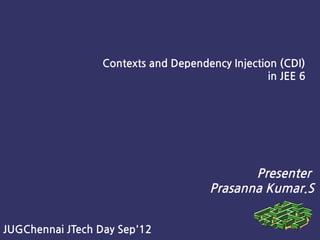CDI in JEE6
- 1. Contexts and Dependency Injection (CDI) in JEE 6 Presenter Prasanna Kumar.S JUGChennai JTech Day Sep'12
- 2. About me A Java developer (now interested in Scala as well ...) Active member in JUG Chennai Creator & Co-Founder of scalaxia.com (a site which lists out the popular tweets about scala) Contributed for ScalaFX project Contact Mail me prassee.sathian@gmail.com Follow me @prasonscala I blog @ prasonscala@tumblr.com
- 3. Agenda What is & Why DI ? What is CDI Features of CDI Advantages of CDI Injecting Beans (with some EJB tit-bits !!!) Types of Injection Qualifiers â Built in & custom qualifiers Scope â Types of Scopes CDI options.... Questions
- 4. What is Dependency Injection PHONE ==> SIM ==> TOWER
- 5. Why Dependency Injection user just relies (on)ly the Phone streamlining dependent objects injection by âDon't call your service, let service call youâ Achieve loose coupling of objects Well proven practise
- 6. What is CDI ïĻ JSR 299 ïĻ Provides a unifying Dependency Injection and contextual life cycle model for Java EE ïĻ A completely new, richer dependency management model ïĻ Type-safe dependency injection ïĻ Designed for use with stateful objects (scoped objects)
- 7. Advantages of CDI Decouple server and client â Using well-defined types and qualifiers â Allows server implementations to vary Decouple lifecycle of collaborating components â Automatic contextual lifecycle management by the CDI runtime Decouple orthogonal concerns (AOP) â Interceptors & Decorators NO XML !!!! Can be used in both JAVA SE and JAVA EE applications
- 8. Injecting Beans CDI is all about DI CDI makes use of annotations 3 Types of injection points ïŽ Field ïŽ Method Parameter Methods can be ïŽ Constructor ïŽ Initializer ïŽ Setter ïŽ Producer ïŽ Observer
- 9. Basic CDI Beans public interface Greeting { public String greet(String greet); } @Default public class PlainGreetingCDI implements Greeting { public String greet(String greet) { return "greetings to " + greet; } } // client code @Inject private Greeting greeting; public String sayGreeting(String whomToGreet) { return greeting.greet(whomToGreet); }
- 10. Qualifiers â Built in & custom quali- fiers public interface CurrencyConverter { public Double convert(Double howMuchToConvert); } @Qualifier @Retention(RUNTIME) @Target({ TYPE, METHOD, FIELD, PARAMETER }) public @interface CurrencyType { VariousCurrencies type() default VariousCurrencies.DOLLAR; } @CurrencyType(type = VariousCurrencies.DOLLAR) public class DollarConverter implements CurrencyConverter { @Override public Double convert(Double howMuchToConvert) { return howMuchToConvert * 55; } } public enum VariousCurrencies { DOLLAR,EURO,POUNDS }
- 11. Qualifier in CDI public interface CurrencyConverter { public Double convert(Double howMuchToConvert); } @Qualifier @Retention(RUNTIME) @Target({ TYPE, METHOD, FIELD, PARAMETER }) public @interface CurrencyType { VariousCurrencies type() default VariousCurrencies.DOLLAR; } @CurrencyType(type = VariousCurrencies.DOLLAR) public class DollarConverter implements CurrencyConverter { @Override public Double convert(Double howMuchToConvert) { return howMuchToConvert * 55; } } public enum VariousCurrencies { DOLLAR,EURO,POUNDS }
- 12. Qualifier in CDI (Contd) // client code @Inject @CurrencyType private CurrencyConverter def_converter; @Inject @CurrencyType(type=VariousCurrencies.EURO) private CurrencyConverter euroConverter;
- 13. Scoped Beans â Request Scope @RequestScoped public class RequestScopedCurrencyConverterCDI { private double currValue; @Inject @CurrencyType(type=VariousCurrencies.DOLLAR) private CurrencyConverter currencyConverter; // setters and getter for currencyConverter public double convert() { return currencyConverter.convert(currValue); } }
- 14. Scoped Beans â Request Scope @Stateless public class ScopedCurrencyConverterEJB { @Inject private RequestScopedCurrencyConverterCDI currencyConverterCDI @EJB private FormattedCurrencyConverter formattedCurrencyConverter; public String getConvertedValue(double valueToConvert) { currencyConverterCDI.setCurrValue(valueToConvert); return formattedCurrencyConverter.getFormattedCurrency(); } } @Stateless @LocalBean public class FormattedCurrencyConverter { @Inject private RequestScopedCurrencyConverterCDI currencyConverter; public String getFormattedCurrency() { return "The converted "+ currencyConverter.getCurrValue() +" to " + currencyConverter.convert(); } }
- 15. Scoped Beans â Request Scope // client code @EJB private ScopedCurrencyConverterEJB converterEJB; converterEJB.getConvertedValue(2) // "The converted 2.0 to 110.0"
- 16. Scoped Beans â Application Scope @ApplicationScoped public class ApplicationScopedCDI { private double currValue; public void setCurrValue(double currValue) { this.currValue = currValue; } public double getCurrValue() { return currValue; } } // client code public void setValueToConvert(double value) { applicationScopedCurrencyConverterCDI.setCurrValue(2); } public double getValueToConvert() { return applicationScopedCurrencyConverterCDI.getCurrValue(); }
- 17. Scoped Beans â Application Scope @ApplicationScoped public class ApplicationScopedCDI { private double currValue; public void setCurrValue(double currValue) { this.currValue = currValue; } public double getCurrValue() { return currValue; } } // client code public void setValueToConvert(double value) { applicationScopedCurrencyConverterCDI.setCurrValue(2); } public double getValueToConvert() { return applicationScopedCurrencyConverterCDI.getCurrValue(); }
- 18. CDI options Reference Implementations JBoss Weld http://seamframework.org/Weld Apache OpenWebBeans http://openwebbeans.apache.org/owb/indexhtml Caucho http://www.caucho.com/ Supported App Containers Jboss AS 7,GlassFish 3.1x ,Caucho, TomEE !!! & all JEE6 containers
- 19. How do I learn / adopt All code presented here are available under https://github.com/prassee/JTechDayCDIExamples You are welcome to contribute your own examples - (Shameless sales pitch !!!!) Project using CDI AGORAVA project - http://agorava.org/ Feel free to contribute JavaPassion site http://javapassion.com/jugtalks TomEE examples Trunk http://tomee.apache.org/examples-trunk/index.html
- 20. Q&A




















